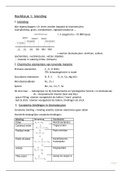Solution Manual For
to accompany
CONTEMPORARY CANADIAN BUSINESS LAW
PRINCIPLES & CASES
TWELFTH EDITION
John A. Willes, QC
BA, LLB, MBA, LLM
Barrister-at-Law
Barrister and Solicitor, Notary
Professor Emeritus, Queen‘s University
John H. Willes
BComm, LLB, MBA, LLM, CIM, FSALS
Barrister and Solicitor, Notary
, CHAPTER 1. THE LAW AND THE LEGAL SYSTEM
Chapter Topics
Learning the Law
The Legal Environment of Business
The Nature of Law
Rights versus Privileges
The Role of Law
The Early Development of Law
The Rise of the Courts and the Common Law
The Sources and Components of Modern Canadian Law
The Constitutional Foundations of Canadian Law
The Canadian Charter of Rights and Freedoms
Classification of Laws
Summary
Key Terms
Review Questions
Mini-Case Problems
Case Problems for Discussion
Chapter Objectives
The rights and obligations of businesses and business persons stem from the
law and our legal system. After study of this chapter, students should be able to:
• Describe the sources, role and development of Canadian law.
• Distinguish between statute and Common Law, and describe the
significance of stare decisis.
• Recognize matters of federal versus provincial jurisdiction.
• Describe the fundamental rights and freedoms set out in the
Charter of Rights and Freedoms.
CHAPTER COMMENTARY
Chapter 1 is introductory in nature, and provides a general background concerning the nature of law, how
laws developed, the general need for some rules to govern the behaviour of individuals, and the establishment
of the various fundamental rights and duties of persons in society.
In class discussion, special emphasis should be placed upon both the sources of law and the
classification of laws in order that students may have a clear idea of what they are and where they may be
found. Many students fail to realize that the Common Law represents a large body of law, and the scope and
application of this source of law should be emphasized in class discussion of the chapter. The text
description of the development of the law and the rise of the courts is intended to be read as a historical
introduction to give students an appreciation of where our laws came from, and how they were developed. In
the context of the courts and the law, the doctrine of stare decisis should be noted, and its purpose and
application discussed with emphasis on the need for "predictability" in the application of the law to cases that
come before the courts. It would be worthwhile to note as well that some judges of the Supreme Court of
Canada have expressed the view that they, as judges of the highest court in the land, do not consider
Willes, Contemporary Canadian Business Law, 12e
© 2020 Copyright by McGraw-Hill Limited
Instructor‘s Manual
1-2
,themselves bound by the doctrine, but would only change a common law rule where it had become
inappropriate in a modern social setting.
Chapter 1 also provides a general outline of the nature of a constitution and its function in a
democratic society. Reference is made to the "constitution" of the United Kingdom and the constitution of
the United States as a basis for discussion of, and comparison with, the Canadian Constitution. The role of the
courts as the chief interpreter of the constitution is also noted and should be emphasized in any class
discussion of the enforcement of rights under the Charter. On this point, the doctrine of judicial review should
be explained to illustrate how the rights of both governments and individuals set out in the constitution may
be enforced. As an approach to teaching this part of the chapter, a systematic examination of the fundamental
rights and freedoms may be made with the class requested to provide a fact situation related to a freedom or
right, and then have the class speculate as to how the Charter might be interpreted by the court as it relates to
the matter. With each fundamental right or freedom it is important to emphasize that the freedom or right
must be viewed in the light of s.1 which makes the right "subject only to such reasonable limits prescribed by
law as can be demonstrably justified in a free and democratic society," and not absolute. The
"notwithstanding" clause (s. 33) which permits legislatures or parliament to override the Charter rights should
be noted as well. On this point, reference may be made to the Court Decision in the Chapter (Ford v. Quebec
(Attorney General), 1988 CanLII 19 (SCC)) which held Quebec's Bill 101 unconstitutional with respect to
public signs. Students should note that the province of Quebec used s. 33 to override this decision of the
Supreme Court of Canada and passed Bill 178 to require "French only" signs on all Quebec businesses.
Students should also examine RJR-MacDonald Inc. and Imperial Tobacco Ltd. v. Canada, 1995 CanLII 64
(SCC) in the Chapter for an additional example of the views of the Supreme Court on the Government of
Canada's attempts to virtually ban advertising on tobacco products.
The organization of the Charter itself provides an orderly approach to discussion of the nature of the
rights and freedoms granted under it, as well as the method of enforcement. With respect to the latter, it is
readily apparent that most of the rights and freedoms are those which the framers of the constitution felt
should be enshrined to protect them from encroachment or interference by governments. If government
should do so, the individual has the right to bring the alleged infringement before the courts to have the
interference ruled upon as to its validity.
A final point to note and to emphasize in class is that the constitution includes more than the Charter
of Rights and Freedoms. It also includes the original British North America Act of 1867 (as amended over
the years) which establishes the structure of our government, and the legislative powers and jurisdiction of the
provincial governments and Parliament. Consequently, it is a lengthy and complex document which sets out
not only the rights and freedoms of the individual, but how Canada as a democratic society governs itself. On
this point it should be emphasized that legislative bodies may not exceed the powers granted to them under
the constitution, as the exercise of jurisdiction when none exists renders such an act ultra vires and a nullity.
Aboriginal and indigenous law concepts are introduced, and statute law is defined in the text, and the
process associated with this type of law-making is described very briefly. Students should be informed that
this process is legislative as distinct from judicial. The recording and organization of these statutes in the
form of revised statutes of a province (or federal government) should also be discussed in order that students
are made aware of where these laws may be found. Discussion may then lead into the topic of civil codes,
and students may be asked to discuss the pros and cons of a Civil Code system vs. the Common Law/Equity
system
Willes, Contemporary Canadian Business Law, 12e
© 2020 Copyright by McGraw-Hill Limited
Instructor‘s Manual
1-3
, From the point of view of learning about the law, the chapter contains a description of the various
sources of the law, and the methods of classification. The importance of this part of the chapter should be
underscored, as it provides the basis for an understanding of the particular rules and principles covered in the
remainder of the text. It also represents an important first step in the examination of the law, in that it sets out
the system for classification.
It is essential that the difference between substantive law and procedural law be understood. As well,
students should learn the various sub-classes of substantive law. In this regard, the nature of public law as a
type of substantive law should be clearly understood. Public laws are laws which relate to the relationship
between the individual and the government (or its agencies), and as such, are usually laws which are enforced
by the Crown. They are generally prohibitive or regulatory in nature (e.g.: the criminal law, or provincial
liquor control laws), and are enforced by the Crown if they are violated by an individual. They are quite
different from private laws which normally establish the rights and duties of individuals in their dealings with
each other, and which must be enforced by the party whose rights have been violated.
The chapter outlines the sources of law, and provides a general explanation of the common law
(including equity) as a source. The nature of this body of law should also be carefully examined, as the law
described in a large part of the text is of this type. In particular, the Law of Tort in Chapters 4 - 6, the Law of
Contract in Chapters 7 - 14, the Law of Agency in Chapter 15, the Law of Bailment in Chapter 20, and a
number of other areas of the law are essentially part of the "Common Law".
Chapter 1 also introduces the first of many legal terms and definitions which must not only be
memorized, but understood. The various definitions of the term "law" along with definitions of "rights" and
"privileges", "Common Law", "equity", the doctrine of stare decisis, "statute", and "civil code" are explained,
and the material concerning these terms should be carefully reviewed, as the terms are frequently used
throughout the balance of the text. The various terms used to describe the different classifications of the law
should also be noted.
The Review Questions at the end of the chapter should provide a sufficient test of student knowledge
of the essential material and are reproduced with comments.
Review Questions
1. What impact does the Canadian Charter of Rights and Freedoms have on rights and freedoms not
mentioned specifically in the Charter? Could these "other rights and freedoms" be curtailed or
extinguished by governments?
Answer: The Charter recognizes the existence of other rights and permits them to continue except where
they conflict with Charter rights and freedoms. Rights outside the Charter do not have Charter
protection, and may be abolished or encroached upon by governments.
2. What is the difference between a "right" and a "privilege"?
Answer: A right is an act that may be done with impunity and with the support and recognition of the
state. The state recognizes a right as something which neither it nor others may deny. A privilege is
something which the state allows or permits under specific circumstances at the pleasure of the state.
Willes, Contemporary Canadian Business Law, 12e
© 2020 Copyright by McGraw-Hill Limited
Instructor‘s Manual
1-4






